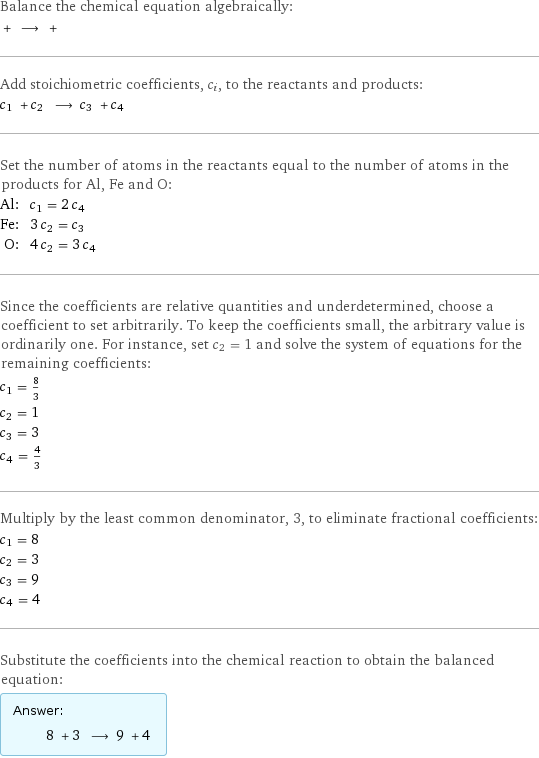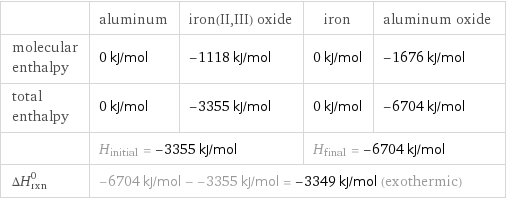Input interpretation

aluminum + iron(II, III) oxide ⟶ iron + aluminum oxide
Balanced equation

Balance the chemical equation algebraically: + ⟶ + Add stoichiometric coefficients, c_i, to the reactants and products: c_1 + c_2 ⟶ c_3 + c_4 Set the number of atoms in the reactants equal to the number of atoms in the products for Al, Fe and O: Al: | c_1 = 2 c_4 Fe: | 3 c_2 = c_3 O: | 4 c_2 = 3 c_4 Since the coefficients are relative quantities and underdetermined, choose a coefficient to set arbitrarily. To keep the coefficients small, the arbitrary value is ordinarily one. For instance, set c_2 = 1 and solve the system of equations for the remaining coefficients: c_1 = 8/3 c_2 = 1 c_3 = 3 c_4 = 4/3 Multiply by the least common denominator, 3, to eliminate fractional coefficients: c_1 = 8 c_2 = 3 c_3 = 9 c_4 = 4 Substitute the coefficients into the chemical reaction to obtain the balanced equation: Answer: | | 8 + 3 ⟶ 9 + 4
Structures

+ ⟶ +
Names

aluminum + iron(II, III) oxide ⟶ iron + aluminum oxide
Reaction thermodynamics
Enthalpy

| aluminum | iron(II, III) oxide | iron | aluminum oxide molecular enthalpy | 0 kJ/mol | -1118 kJ/mol | 0 kJ/mol | -1676 kJ/mol total enthalpy | 0 kJ/mol | -3355 kJ/mol | 0 kJ/mol | -6704 kJ/mol | H_initial = -3355 kJ/mol | | H_final = -6704 kJ/mol | ΔH_rxn^0 | -6704 kJ/mol - -3355 kJ/mol = -3349 kJ/mol (exothermic) | | |
Chemical names and formulas

| aluminum | iron(II, III) oxide | iron | aluminum oxide Hill formula | Al | Fe_3O_4 | Fe | Al_2O_3 name | aluminum | iron(II, III) oxide | iron | aluminum oxide IUPAC name | aluminum | | iron | dialuminum;oxygen(2-)